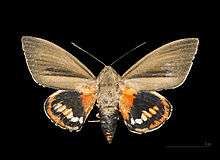Castniidae
Castniidae, or castniid moths, is a small family of moths with fewer than 200 species: The majority are Neotropical with some in Australia and a few in south-east Asia. These are medium-sized to very large moths, usually with drab, cryptically-marked forewings and brightly coloured hindwings. They have clubbed antennae and are day flying, and are often mistaken for butterflies. Indeed, some previous classification systems placed this family within the butterflies or skippers. The Neotropical species are commonly known as giant butterfly-moths, the Australian and Asian species as sun moths. The larvae are internal feeders, often on roots of epiphytes or on monocotyledons (Edwards et al., 1999: 184-188).
| Giant butterfly-moths and sun moths | |
|---|---|
 | |
| Paysandisia archon | |
| Scientific classification | |
| Kingdom: | Animalia |
| Phylum: | Arthropoda |
| Class: | Insecta |
| Order: | Lepidoptera |
| Superfamily: | Sesioidea |
| Family: | Castniidae Boisduval, 1828 |
| Subfamilies & genera | |
|
See text | |
Taxonomy
Subfamily Castniinae
- Tribe Castniini
- Amauta
- Athis
- Castnia
- Castniomera
- Corybantes
- Eupalamides
- Feschaeria
- Geyeria
- Haemonides
- Hista
- Imara
- Insigniocastnia
- Ircila
- Lapaeumides
- Spilopastes
- Synpalamides
- Telchin
- Xanthocastnia
- Yagra
- Tribe Gazerini
- Tribe Synemonini
Subfamily Tascininae
Subfamily incertae sedis
References
- Edwards, Edward D.; Gentili, Patricia; Horak, Marianne; Kristensen, Niels P.; Nielsen, Ebbe S. (1998). "11. The Cossoid/Sesioid Assemblage". Band 4: Arthropoda, 2 Hälfte: Insecta, Lepidoptera, Moths and Butterflies, Teilband/Part 35, Volume 1: Evolution, Systematics, and Biogeography. doi:10.1515/9783110804744.181. ISBN 9783110804744.
External links
- Natural History Museum Lepidoptera genus list
- Tree of Life
- Australian Moths Online
- Sun Moths
- Australian Castniidae
- Castniidae Images